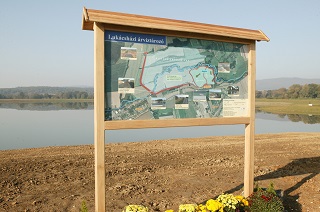A new facility built in West Transdanubia, Hungary, is decreasing the risk of flood damage in settlements along the Gyöngyös and Sorok-Perint streams, as well as increasing the ecological value of the area.
- 01 February 2016
Reservoir Construction
In the frame of the project a new facility was built that can store 5.2 million meters3 of water in case of flood. The facility only releases as much water as needed into the watercourse below, thus decreasing the risk of floods or flood damages. New structures now can be built safely on the existing floodplain.
The facility includes a 145 hectares peak flood-reducing reservoir, a 2 405 meter dam and a water-level regulating structure. The reservoir and the ecological wetland consisting of two lakes with 24 hectares water surface formed on the barrow pit can be found between Kőszeg and Lukácsháza along the Gyöngyös stream.
Safety Impact
The new facility is expected to protect 25 000 people from floods, specifically those living in the previously risky areas of Lukácsháza, Gyöngyösfalu, Gencsapáti, Szombathely, Balogunyom, Sorkifalud, Sorkikápolna, Zsennye.
Beyond protecting residents, the new two-part lake can be used for tourism and leisure purposes. The ecological value of the area and surrounding waterways will increase with the creation of the dam, as the watercourses can be kept in natural conditions due to only small amounts of water being released from the reservoir at a time. Implementation of the project gives possibility for further developments in the floodplain and it is connecting to the Perint revitalisation programme preferred by Szombathely.
Total Investment and EU Funding
Total investment for the project “Lukácsháza Reservoir” is HUF 2 498 203 718 (approximately EUR 7 874 125), of which the EU’s European Regional Development Fund is contributing HUF 2 123 473 160 (approximately EUR 6 693 006) from the Operational Programme “West Pannon” for the 2007 to 2013 programming period, under the priority axis “Improving the quality of surface waters, reducing the risks caused by surface waters.”

